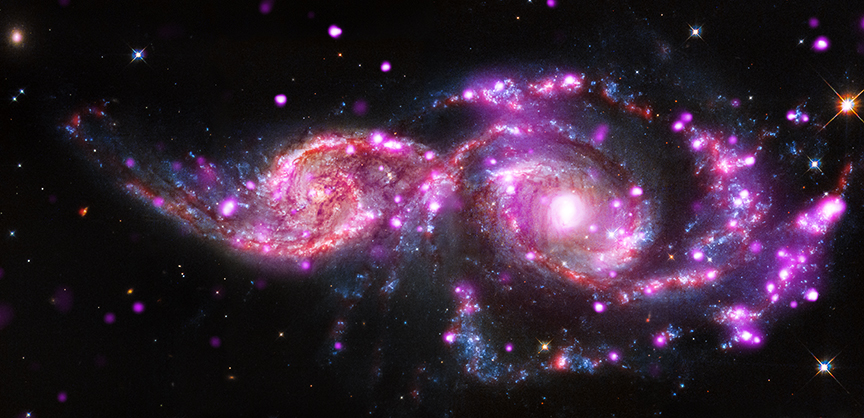NASA | MSFC | SAO | Chandra X-ray Observatory | 2014 Dec 11
At this time of year, there are lots of gatherings often decorated with festive lights. When galaxies get together, there is the chance of a spectacular light show as is the case with NGC 2207 and IC 2163
Located about 130 million light years from Earth, in the constellation of Canis Major, this pair of spiral galaxies has been caught in a grazing encounter. NGC 2207 and IC 2163 have hosted three supernova explosions in the past 15 years and have produced one of the most bountiful collections of super bright X-ray lights known. These special objects - known as "ultraluminous X-ray sources" (ULXs) - have been found using data from NASA's Chandra X-ray Observatory.
As in our Milky Way galaxy, NGC 2207 and IC 2163 are sprinkled with many star systems known as X-ray binaries, which consist of a star in a tight orbit around either a neutron star or a "stellar-mass" black hole. The strong gravity of the neutron star or black hole pulls matter from the companion star. As this matter falls toward the neutron star or black hole, it is heated to millions of degrees and generates X-rays.
ULXs have far brighter X-rays than most "normal" X-ray binaries. The true nature of ULXs is still debated, but they are likely a peculiar type of X-ray binary. The black holes in some ULXs may be heavier than stellar mass black holes and could represent a hypothesized, but as yet unconfirmed, intermediate-mass category of black holes. ...
A Comprehensive X-ray and Multiwavelength Study of the Colliding Galaxy Pair NGC 2207/IC 2163 - S. Mineo et al
- Astrophysical Journal 797(2):91 (2014 Dec 20) DOI: 10.1088/0004-637X/797/2/91
- arXiv.org > astro-ph > arXiv:1410.2472 > 09 Oct 2014 (v1), 13 Oct 2014 (v2)
